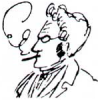Well, theres the integral in both the general Ambient Occlusion formula and the rendering equation. You have to use multiple samples to approximate this integral. But I can't think of any correct solution to do it.
You might want to just add all of the samples weighted by their cosine value:
irradiance += L(w) * dot(N, w);
But the more samples you use the brighter it gets. So I thought of dividing the sum by the amount of samples:
foreach (Sample w in Samples)
{
irradiance_sum += L(w) * dot(N, w);
}
irradiance = irradiance_sum / Samples.Count;
That kinda works, but I thought about it a bit more and found out that an infinite amount of samples and a L value of 1 for each sample, doesn't return 1 as result, but 2/pi.
Now maybe we have to divide it by this maximum value of 2/pi. But than the irradiance of just 1 sample turns out to be pi/2.
Can you please help me? An infinite amount of samples still needs to be able to return 100% of the incoming light, same for just 1 sample...
How to calculate Irradiance correctly?
Divide result by accumulated samples dotProduct.
edit: hmm my brains are slow.
foreach (sample in allSamples) {
acc += dot(sample.dir, normal)
irradiance += sample.color
}
irradiance /= acc;
/Tyrian
Ps: I`m bit tired, so double check is neaded!
edit: hmm my brains are slow.
foreach (sample in allSamples) {
acc += dot(sample.dir, normal)
irradiance += sample.color
}
irradiance /= acc;
/Tyrian
Ps: I`m bit tired, so double check is neaded!
Ok, well this was one of the things I tried as well... I tried 2 versions of your solution....
Yours results in light being 57% brighter than the incoming light...
And a different version:
foreach(Sample w in Samples)
{
irradiance_sum += dot(N, w) * L(w);
cosine_sum += dot(N, w);
}
irradiance = irradiance_sum / cosine_sum;
That nearly works but doesn't for just 1 sample since it would be like that:
irradiance = dot(N, w) / dot(N, w) * L(w);
It just kills off the diffuse lighting completely...
Yours results in light being 57% brighter than the incoming light...
And a different version:
foreach(Sample w in Samples)
{
irradiance_sum += dot(N, w) * L(w);
cosine_sum += dot(N, w);
}
irradiance = irradiance_sum / cosine_sum;
That nearly works but doesn't for just 1 sample since it would be like that:
irradiance = dot(N, w) / dot(N, w) * L(w);
It just kills off the diffuse lighting completely...
I believe this is the correct solution:
foreach (Sample w in Samples)
{
irradiance_sum += L(w) * dot(N, w);
cosine_sum += dot(N, w);
}
irradiance = irradiance_sum*2.0*PI / cosine_sum;
Check page 9 of "Stupid Spherical Harmonics Tricks"
foreach (Sample w in Samples)
{
irradiance_sum += L(w) * dot(N, w);
cosine_sum += dot(N, w);
}
irradiance = irradiance_sum*2.0*PI / cosine_sum;
Check page 9 of "Stupid Spherical Harmonics Tricks"
Well, this is basically the same as I've posted before, just multiplied by 2*pi... It still kills off the diffuse lighting with just 1 sample...
I believe the normalization factor must be something like that:
irradiance = (Samples.Count + 2) / (2*pi) * irradiance_sum;
This obviously isn't correct... But I've seen this normalization factor multiple times before for normalizing the specular highlights brightness... But maybe something like this would work here as well...
Also the paper you posted itself says that it's not totally right and only works with hi-res cube-maps, which is the same I said... pi / 2 * irradiance_sum / Samples.Count only works with an infinite amount of samples...
[Edited by - DarkChris on September 29, 2010 1:41:05 PM]
I believe the normalization factor must be something like that:
irradiance = (Samples.Count + 2) / (2*pi) * irradiance_sum;
This obviously isn't correct... But I've seen this normalization factor multiple times before for normalizing the specular highlights brightness... But maybe something like this would work here as well...
Also the paper you posted itself says that it's not totally right and only works with hi-res cube-maps, which is the same I said... pi / 2 * irradiance_sum / Samples.Count only works with an infinite amount of samples...
Quote:but it tends to be a little off (particularly when using low resolution cube maps.)
[Edited by - DarkChris on September 29, 2010 1:41:05 PM]
You have to weight each sample by the solid angle the sample represents. This is the area of the unit sphere subtended by the sample.
If your samples are uniform on the sphere, this is easy (2pi/numsamples). If you're sampling the sphere over lattitude/longitude a.k.a. theta/phi, the weight of each sample would be (2pi/xsamples)*(pi/ysamples)*sin(theta) or more simply sin(theta)*2*pi_squared/(numsamples)
If you're integrating over a hemisphere rather than a sphere, adjust by a factor of 2. If you want to normalize your irradiance to "lambertian unity" you have to divide by pi somewhere.
If your samples are uniform on the sphere, this is easy (2pi/numsamples). If you're sampling the sphere over lattitude/longitude a.k.a. theta/phi, the weight of each sample would be (2pi/xsamples)*(pi/ysamples)*sin(theta) or more simply sin(theta)*2*pi_squared/(numsamples)
If you're integrating over a hemisphere rather than a sphere, adjust by a factor of 2. If you want to normalize your irradiance to "lambertian unity" you have to divide by pi somewhere.
Wow, that seems to be about right... Thank you and not only you but all of you for helping... I'll test this one out, but I'm quite sure that it's right, since sine actually is the integral of cosine... I somehow totally forgot that it might be useful here...
Well, in an attempt to introduce the correct weights and explain a bit more:
You have to be aware that the weight of each sample depends on how you draw it.
If you weight your samples with solid angle you have to be careful that
1. They cover the whole (hemi)sphere
2. They don't overlap
(3. You associate the correct solid angle with each sample)
This may sound obvious but it is easy to get wrong in practice.
If you are integrating _uniformly_ spaced samples over the FULL unit sphere the weight is 4*pi/nSamples for each sample (for the HEMIsphere it is 2*pi/nSamples). (And here uniformly spaced means uniformly with respect to surface area.) You can verify your weights to some extent by integrating 1. The result should be the surface area of the sphere/hemisphere.
As irradiance makes only sense with respect to a surface (though maybe an imaginary one) I assume you want to integrate over the hemisphere. Also be aware that one sample in the case of irradiance is Li(wi)*dot(n,wi), i.e. the incident _radiance_ from direction wi times the cosine of the angle between the surface normal and incidient direction. Not just the radiance.
To get to the point, your basic loop looks like this:
For uniformly distributed samples over the hemisphere weight = 2*pi/nSamples.
If you are sampling in spherical coordinates with uniformly spaced theta and phi, and the spacings are dPhi = 2*pi/nPhi and dTheta = 0.5*pi/nTheta, then weight = sin(theta)*dTheta*dPhi.
sin(theta) comes from the fact that when you lay a grid over the sphere with theta and phi evenly spaced you get bigger patches at the 'equator' (theta=pi/2) than at the 'poles' (theta=0 or pi). And for infinitesimal dTheta and dPhi the area of one patch is sin(theta)*dTheta*dPhi (your weight). The sine is not related to the cosine in the integrant.
You have to be aware that the weight of each sample depends on how you draw it.
If you weight your samples with solid angle you have to be careful that
1. They cover the whole (hemi)sphere
2. They don't overlap
(3. You associate the correct solid angle with each sample)
This may sound obvious but it is easy to get wrong in practice.
If you are integrating _uniformly_ spaced samples over the FULL unit sphere the weight is 4*pi/nSamples for each sample (for the HEMIsphere it is 2*pi/nSamples). (And here uniformly spaced means uniformly with respect to surface area.) You can verify your weights to some extent by integrating 1. The result should be the surface area of the sphere/hemisphere.
As irradiance makes only sense with respect to a surface (though maybe an imaginary one) I assume you want to integrate over the hemisphere. Also be aware that one sample in the case of irradiance is Li(wi)*dot(n,wi), i.e. the incident _radiance_ from direction wi times the cosine of the angle between the surface normal and incidient direction. Not just the radiance.
To get to the point, your basic loop looks like this:
E = 0;foreach(direction wi){ E += Li(wi) * dot(n,wi) * weight;}For uniformly distributed samples over the hemisphere weight = 2*pi/nSamples.
If you are sampling in spherical coordinates with uniformly spaced theta and phi, and the spacings are dPhi = 2*pi/nPhi and dTheta = 0.5*pi/nTheta, then weight = sin(theta)*dTheta*dPhi.
sin(theta) comes from the fact that when you lay a grid over the sphere with theta and phi evenly spaced you get bigger patches at the 'equator' (theta=pi/2) than at the 'poles' (theta=0 or pi). And for infinitesimal dTheta and dPhi the area of one patch is sin(theta)*dTheta*dPhi (your weight). The sine is not related to the cosine in the integrant.
"If you are integrating _uniformly_ spaced samples over the FULL unit sphere the weight is 4*pi/nSamples for each sample (for the HEMIsphere it is 2*pi/nSamples)"
quite right... my apologies
quite right... my apologies
Yeah, I forgot to mention that. Always calculate the irradiance using evenly spaced samples!
If you don't know how to generate evenly spaced sampling vectors, then this is what you need.
If you need sampling directions for the upper hemisphere then you can easily modify the algorithm presented in that page.
If you don't know how to generate evenly spaced sampling vectors, then this is what you need.
If you need sampling directions for the upper hemisphere then you can easily modify the algorithm presented in that page.
This topic is closed to new replies.
Advertisement
Popular Topics
Advertisement



